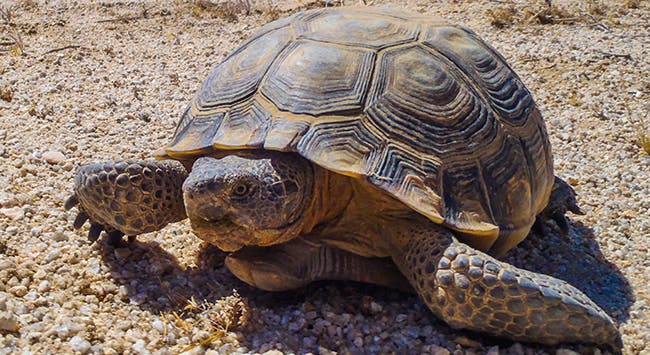The U.S. Bureau of Land Management (BLM) has proposed doubling off-road vehicle routes in the western Mojave Desert, placing the already threated desert tortoise in greater danger.
California has the greatest number of off-road vehicle enthusiasts in the U.S. Nowhere is this more evident than within the California Desert Conservation Area, which encompasses the western Mojave Desert, as well as several counties in southeastern California.
There are 11 open off-road vehicle use play areas in this region alone. Yet use of off-road vehicles outside these play areas, is almost completely uncontrolled. ATVs riding through this region can cause long-term impacts to soil, vegetation and wildlife, and has severely degraded sensitive wildlife habitat on both private and public lands.
No other species has felt the negative effects of off-road vehicle recreation as much as Agassiz’s desert tortoise. Supremely adapted to the rigors of desert life, this tortoise has survived millennia in its creosote bush scrub habitat. That is, until livestock grazing, rapid human development, solar development and off-road vehicles etched their way into every facet of the California State Reptile’s life.
The Tortoises’ Troubles
Plagued by habitat loss, degradation and fragmentation, desert tortoises have had it pretty tough. Agassiz’s desert tortoise was designated a threatened species under the Endangered Species Act in 1990. Following the growth of more than 100 desert communities and decades of livestock grazing, the species then suffered through the taking of tortoises as pets, shooting/vandalism and extensive mortality on highways. Tortoise populations have been hit hardest in the western Mojave Desert.
The intentional release of pet tortoises (and their unintentional escape to the wild) in the wake of these combined human impacts may be responsible for the subsequent spread of a highly contagious disease that has decimated once-robust tortoise populations. If this weren’t enough, the common raven has increased exponentially in expanding desert communities, and is now targeting tortoise hatchlings as a food source.
While tortoise populations continue to decline, recreational vehicle use in the tortoise’s shrinking habitat has skyrocketed. The BLM has designated a few official routes and trails to try to stem the tide of illegal off-road vehicle use. But so far, it hasn’t been enough to limit the impact on desert tortoises.
Uncontrolled off-road vehicle use has crushed tortoises, collapsed burrows, and destroyed the cover vegetation that tortoises use to escape heat and travel through their territories. In soils disturbed by vehicle use, plant species that tortoises prefer to eat are commonly replaced with weedy plants of less nutritional value. Tire tracks and trails seldom disappear on their own, and certain impacts on the soil and vegetation last for decades. To make matters worse, almost every tire track illegally created in tortoise habitat is followed by another recreational vehicle user, creating a spiderweb of impacts that spirals out of control over time.
Sadly, things are about to get even worse for desert tortoises in the western Mojave. The BLM plans to designate more off-road vehicle routes in the last remaining, highly fragmented tortoise habitat in this region. In fact, they’ve proposed more than 10,000 miles of off-road vehicle routes, which would double the amount of off-road vehicle routes!
We need the BLM to reduce impacts of off-road vehicles by restricting them to very specific areas, and increasing the fines for those who break the rules. The agency should also designate many large, natural areas as protected from any off-road vehicle use to help keep desert tortoises safe, and restore any desert tortoise critical habitat that has been damaged by off-road vehicles in a timely manner.
Having adapted so well to the harsh environment of the Mojave Desert, this tortoise is a survivor. But with human impacts to its habitat increasingly putting the species in jeopardy, proactive planning and on-the-ground work are the only ways we can give the desert tortoise a real chance at survival.






